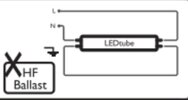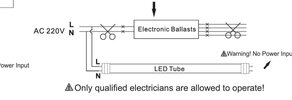One of our old 58W tubes in the kitchen has died so good time to go to LED
im wanting to remove the ballasts and connect direct to mains, its only a single tube light with a Kengo MB58 Ballast

Ive ordered this tube: https://www.lighting.philips.co.uk/...epro-ledtube-em-mains/929003022502_EU/product
Which I believe is single sided so I have to rewire to one side only? (from the videos and posts ive read anyway)
But on the install diagram it shows when removing the ballast its wired in on both sides
so which one shall I do?

There was another post on here (https://www.diynot.com/diy/threads/how-to-remove-ballast-from-led-tube-fitting.469390/) which has a similar setup as mine, and the person just connected the cables going into the ballast together?
Should I be checkign for shunted and non shunted tomb stones as well?
im wanting to remove the ballasts and connect direct to mains, its only a single tube light with a Kengo MB58 Ballast
Ive ordered this tube: https://www.lighting.philips.co.uk/...epro-ledtube-em-mains/929003022502_EU/product
Which I believe is single sided so I have to rewire to one side only? (from the videos and posts ive read anyway)
But on the install diagram it shows when removing the ballast its wired in on both sides
so which one shall I do?
There was another post on here (https://www.diynot.com/diy/threads/how-to-remove-ballast-from-led-tube-fitting.469390/) which has a similar setup as mine, and the person just connected the cables going into the ballast together?
Should I be checkign for shunted and non shunted tomb stones as well?




